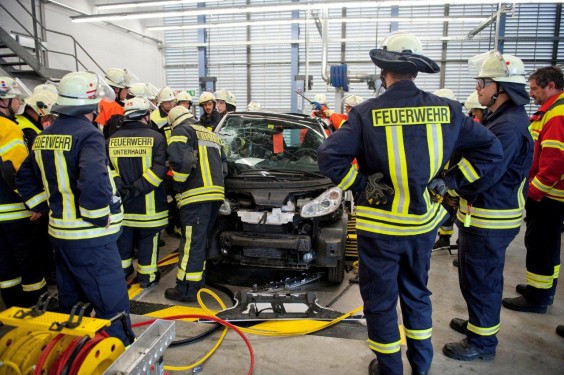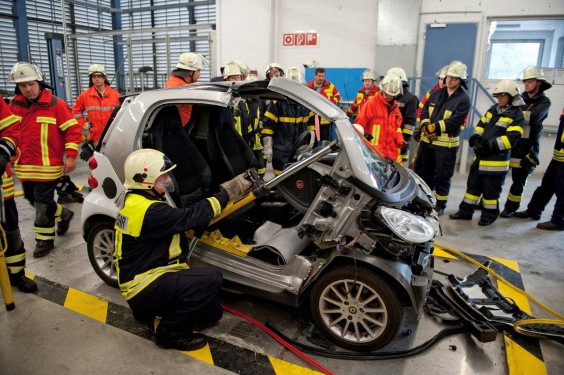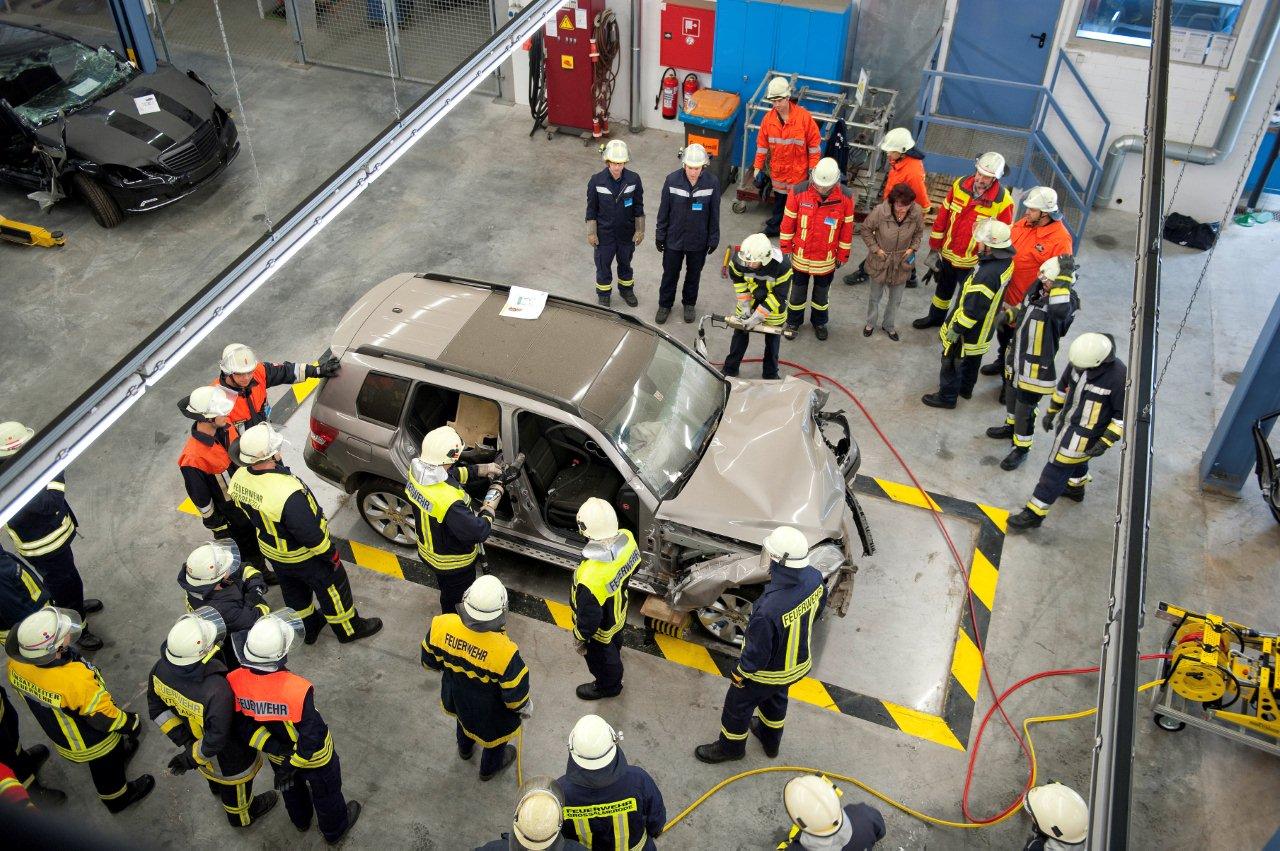
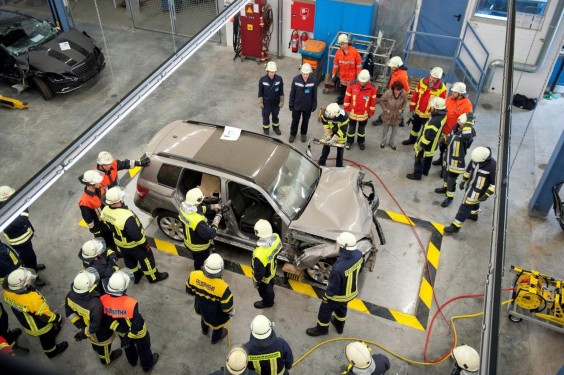
Stuttgart – Mercedes-Benz, Maybach and smart – all car brands which feature among the world’s safest vehicles. The high potential for protection is a result of the holistic approach taken by Daimler AG, which focuses on avoiding traffic accidents as well as reducing both the severity and the consequences of accidents. Admittedly protection mechanisms are pushed to their limits when the underlying conditions make the intervention of controlling measures difficult: for example, when a truck driver overlooks the end of a tailback, or when a driver is on the wrong side of the road. More often than not such situations lead to catastrophic accidents – and it is also often no longer possible to gain access via the vehicle doors to rescue the occupants.
Even in these extreme conditions, in which “proper casualty rescue” is the priority, the company continues to apply its safety philosophy in supporting the rescue services. By taking part in practical training sessions, fire services can learn and apply a wide variety of rescue options with the aid of the very latest models. In addition, Daimler provides detailed Guidelines for Rescue Services which point out the different rescue strategies for specific models. After all, the efficiency of the rescue attempts, which may involve paramedics and fire services working together at the scene of an accident to save the occupants as quickly and as carefully as possible, can depend crucially on the preparation.
The scene prepared in a hall at the Mercedes-Benz plant in Sindelfingen is an impressive sight. The scenario: a Mercedes-Benz GLK has crashed into a tree at high speed without braking, heavily deforming the vehicle’s bodywork. As part of the simulated rescue of the occupants, the rescue services – made up of members of different professional and volunteer fire services – must first of all open and remove the doors using special spreading and cutting tools. The roof pillars then need to be separated using hydraulic cutters, so that the roof can be lifted off. By working in this way, the firemen create the conditions for a “proper casualty rescue” which can then be carried out as carefully as possible.
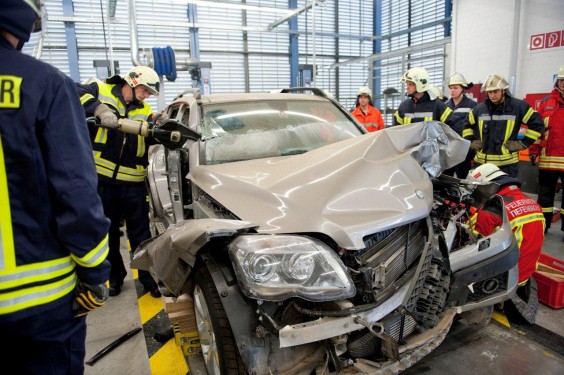
What, when, where, how? Practical training is the key to safety
The simulation described here takes place as part of a practical training session which Daimler AG provides on a regular basis for the rescue services. After a technical introduction to the most extensive variety of safety devices, the fire services are given access to the current vehicles from the Daimler model range in order to practise the correct procedure for dealing with vehicles involved in accidents, under the guidance of experienced and specially-trained Daimler staff. That’s because in an emergency every move has to be exactly right. The slightest hesitation, or even the use of the wrong rescue equipment, could have significant consequences, both for the occupants of the vehicle involved in the accident as well as the rescue services themselves.
This is where a number of detailed questions come to the fore: on which points should the spreading or cutting tools be applied? Which parts of the bodywork contain ultra-high-strength steel – used to enhance passive safety – which might make cutting through the bodywork more difficult or, if older tools are used, even impossible? Where are the inflators for the sidebags or windowbags located, which if possible should not be destroyed in a rescue? The importance of this training is highlighted by Andreas Wilhelm, a member of the Baden-Baden fire service: “Daimler is providing us with some unique practical training here. It is particularly important to learn not only about the latest vehicles themselves, but also how to deal with them in rescue conditions. Normally we have to practise such exercises using scrap cars, which in technical terms are outdated and therefore only of limited use when it comes to preparing for our rescue attempts.”


In addition to the GLK, other models playing a role in the forced-entry training include a Saloon and a Coupé from the new E-Class series, an A‑Class, as well as a smart coupé and a smart cabrio. The fire services are also unanimous about one particular aspect of the vehicles: the particularly high degree of resistance demonstrated by the two compact smart models. Despite the significantly smaller masses involved in these vehicles, the cutting work still requires the use of just as much equipment and force as for the larger models. According to Thomas Hofer, a member of the Daimler works fire service who together with engineers from different development departments trains the fire services: “The participants in our training sessions are always surprised to learn that the size of a vehicle often bears little relation to its stability and resilience.”
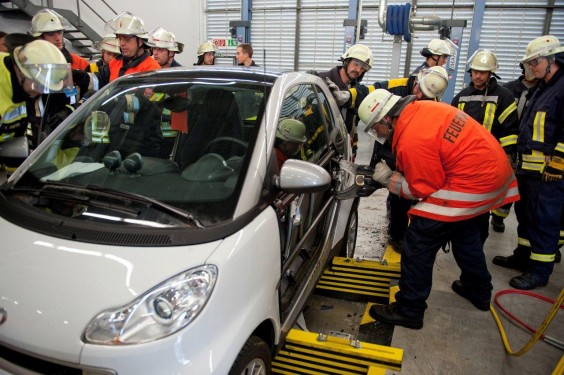
Detailed Guidelines for Rescue Services for passenger cars, vans, trucks, buses and coaches
In addition to practical training, Daimler AG also provides “Guidelines for Rescue Services” which are available for all rescue services. Regularly updated, the documentation contains clear and detailed information for rescue situations relating to all of the current passenger-car series from Mercedes-Benz, Maybach and smart.
The Guidelines for Rescue Services documentation is available in German, English, French, Spanish, Italian and Japanese and can be downloaded free of charge as a PDF document from www.mercedes-benz.de/rettungsleitfaden. By referring to the guidelines, the rescue services can familiarise themselves with the special features of the latest vehicle models in advance and as a result prepare strategies for “proper casualty rescue”. A number of fire services have stored these guidelines on field laptops so that the necessary information can already be called up and referred to on the way to the scene of an accident. Daimler also makes Guidelines for Rescue Services specifically for vans, trucks, buses and coaches available on the same internet platform.

40 years of accident research at Mercedes-Benz
The close cooperation between Daimler safety experts, the rescue services and the police has a long tradition: ongoing accident research at Mercedes-Benz was launched in 1969, in which engineers provided prompt analysis of collisions involving Mercedes-Benz vehicles in Stuttgart and the surrounding area – in some special cases even across the whole of Europe. In this way the studies conducted by accident researchers regularly provided important evidence about vehicle parts that required specific improvement in terms of passive safety. Since the research began some 40 years ago, the researchers have recorded around 4000 accidents. Each crash is documented with an accident report comprising some 80 pages. Thanks to this constantly growing database, vehicles can also continue to be made safer in the future.

